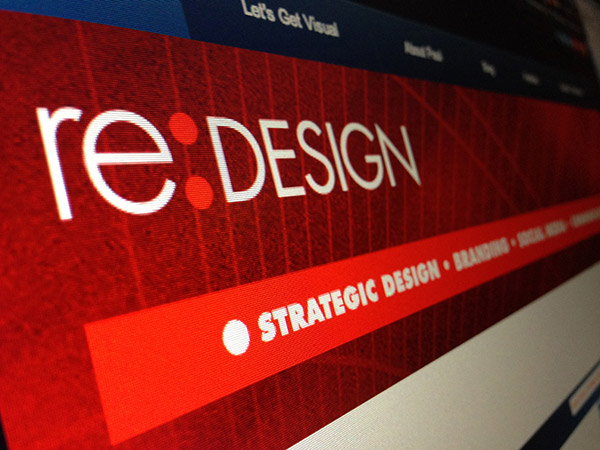Hello everyone! Today we’re very pleased to present an interview with an accomplished graphics professional and true thought leader in the design community, Paul Biedermann. I met Paul on Google Plus, and I was instantly impressed with his online presence. He regularly shares interesting content,and exhibits expertise in content as well as social media marketing. I asked him if he’d share his wisdom with our readers on a variety of design and marketing topics in an exclusive Q & A. I hope you all enjoy the discussion—feel free to ask questions about anything you see below or share your thoughts. Now let’s dive in and hear what Paul has to say!
Paul Biedermann Talks Design, Marketing, and Results for Your Business

1) Can you give our readers a brief bio?
I am Creative Director/Owner of re:DESIGN, an award-winning boutique agency specializing in Strategic Design, Brand Identity, Visual Content Marketing and Communications.
Creating brands of distinction for profitable market advantage by driving real business results, I intersect smart design with business strategies that reach, engage, and inspire people to action — blending both traditional and leading-edge media tactics.
I talk a lot about the competitive advantage that design brings to power business in today’s busy media climate. This includes running the vibrant re:DESIGN Google+ community, speaking at media events and universities and having my articles appear regularly on AllTop, Ragan’s PR Daily, HolyKaw, Yahoo and Business2Community. I have also been featured in FastCompany, HubSpot, and New York’s Newsday. I am honored to appear on numerous “Best Of” lists, including the Top 100 Influencers in Social Media as well as being named in the top 1% of Influencers on Kred.
In my “spare” time, I am Managing Partner and Editor-in-Chief of 12 Most — the best list site on the web, providing daily thought leadership on business and media topics to a global audience.
My work background includes beginning my career at ABC Broadcasting before moving to a design agency that helped put ESPN on the map. As Art Director for the NFL, I created exciting new graphic approaches for the league during an explosive period of growth. As Creative Director for The McGraw-Hill Companies, I spearheaded design, marketing and advertising campaigns for global top-flight brands such as Standard & Poor’s, BusinessWeek, J.D. Power and Associates, Architectural Record, and McGraw-Hill Education.
2) You work in both web and print. Which medium do you prefer?
I do! I think an integrated approach is key for business, and that means paying attention to both online and offline. Every business is different, but just doing one and ignoring the other also means you are ignoring a segment of your market these days.
Web and print are different but similar too. I like that whatever is on the web is never really final — it can always be fixed, tweaked and added to. But therein also lies the challenge, because projects are never really “finished.”
With print, things are a bit more final, but that also has its challenges — and it never hurts to say a little “Hail Mary” when signing off on those printer proofs!
But my goal with most of the businesses I work with is to bridge both worlds — online and offline — for a seamless brand experience. In other words, from business card to website to social media page to event signage, there should be one consistent brand personality that comes across. Not many businesses walk that talk, but they need to!
3) You’re very active on social media, especially Google Plus. Do you think it’s more valuable for designers than LinkedIn or more design-specific sites i.e. Dribble?
All of the main social media platforms serve different functions — each has its pros and cons. I haven’t spent much time with the design-specific sites which I think are more like beauty pageants and the wrong way to hire design. But I think the key for social media is how you bring the different platforms together and balance out your time in a way that works best for your particular situation and goals. As I just stated about the importance of having an integrated approach for online and offline, the same is true for social media.
LinkedIn tends to be the least social of the lot, yet it is a great place to get insights into a person’s work background and to research companies. Every business needs to have a presence there. Facebook is more for friends and family in my opinion, and while bigger companies have success there, I think it is harder for smaller companies to gain traction.
Twitter on the other hand, is a great door opener to people and companies that you might not have a chance to meet otherwise, so I definitely make sure to spend time there, but you’re correct — Google+ is where I now put most of my energies. Besides being a great platform that brings together a lot of the best qualities of the other networks, the focused interaction you find on Google+ is unlike any other social network.
I also founded the re:DESIGN Google+ community which has become a great place to dig into the nitty-gritty of design and what it can do for business. It is for business and marketing people as much as it is for designers, and it’s a place where both sides can mingle, learn and cross-pollinate ideas — which ultimately leads to better work and THAT is really exciting!
4) You maintain an active blog; does writing help you improve your craft?
I think that writing is a very important business advantage these days, so if you can write compelling articles and post on the social networks in a way that draws people in, you have a leg up on the competition. Promoting your blog and sharing links to interesting, helpful content is a a powerful way to drive people to your website — so a blog becomes a critical component of many businesses’ marketing strategies these days.
And yes, writing does help my design too, as I think it helps clarify your thinking and that’s a good thing for your creativity. Comments on my blog and posts also challenge my thinking, so that can be very stimulating as well — the only thing to watch out for there is that you don’t get pulled down the rabbit hole and allow distractions to keep you from the work at hand. For many of us, that is the REAL challenge these days!
5) On your blog you said that content creation isn’t for everybody, and that’s ok. How can small business owners tell they need hired help for content marketing?
That’s a tricky one, because many businesses don’t know how bad their content really is. And it can also be difficult to tell them so without coming across as insulting, but it’s something they need to know.
Design, content and a solid branding strategy are often disregarded as “nice to haves” instead of mission critical. Many businesses think they are easy corners to cut and a cost savings by doing it themselves. This is also one of the reasons I write and share so much about design on the social networks — it’s sort of an educational service so people have a better understanding of what their businesses may be lacking, and what their branding, communications and marketing should aspire to be.
My hope is that maybe a few lightbulbs will go off and they’ll realize they need help and that design is, rather than a cost, a critical investment. Sometimes it works, sometimes it doesn’t — and sometimes you just have to tell them outright how bad they look and hope they’ll see how they are only hurting themselves, which never saves money.
It is incredibly competitive out there, and doing this stuff wrong is basically like shooting yourself in the foot every day — and that can have dire consequences for your business.
6) What’s the #1 design mistake small business owners make?
Um… not hiring a professional designer! The alternative is all-too-frequent and it is blatantly obvious with all the noise that’s out there. First impressions matter — so it’s important to make a good one quick!
There are so many tempting “low cost” alternatives these days: DIY online tools, cookie-cutter templates, crowdsourced solutions, and outsourcing to other countries with lower cost labor — but none of these approaches actually end up saving money because they prolong the time that a company isn’t taking advantage of all that good, effective design has to offer. These approaches: A) don’t produce unique work which is critical to stand apart from the competition and B) never consider the way that good design actually brings value to business.
More than just making something that looks nice, good design is part of an overarching strategy that is developed through a structured process that only comes from close collaboration between the designer and the client. There is back and forth — ideas are shared and designs evolve. Rather than thinking of projects as piecemeal one-offs, there should be a comprehensive strategy or at least an understanding about how your branding and communications fit into a larger picture.
7) Not everyone can afford a professional of your caliber. What do you recommend?
First, I would take an honest assessment and ask if the reason is that I can’t afford design or is it really that I don’t fully appreciate what it can do for my business so I tend to put my money elsewhere. I truly believe that if more people understood the impact that design can have on their business, they will find the money. They certainly find it for other critical needs.
Second, I would talk to a few designers (through recommendations from people you trust) — explain your goals and see if you can’t work out a plan and a budget that works for you. Once you understand how a designer works, you may have a better idea for how the process works and feel more comfortable working with someone who has your best interests in mind.
You will likely also see how an experienced designer will save you money too — perhaps making you aware of things that may have cost a pretty penny down the line that you didn’t foresee. For example, you may have been thinking you need three separate brochures, whereas a designer may suggest one piece with sections that would save on printing, and then perhaps suggest a pocket for inserts that can easily be updated rather than redoing an expensive piece when the information becomes outdated.
That old adage “pennywise, dollar foolish” is very applicable here — taking a low cost shortcut usually ends up costing more later.
8) You write a lot about trust in the designer/client relationship. What can designers do to increase the trust factor from the start?
I think designers need to listen and ask good questions that demonstrate an understanding of someone’s business challenges and a passion for helping their business succeed. I find that when I begin projects with new clients, I get excited about the possibilities that working together will bring to their business. This excitement translates into my work that will hopefully generate the same excitement in their markets, motivating them to act.
Of course, things like being upfront and meeting deadlines and staying on budget are also critical, but once you see that a person has your best interests at heart, how can you not trust them? The more trust there is, the better the work will be — and the more it snowballs.
About the Author
Paul Biedermann earned a BFA in Graphic Communications from Washington University in St. Louis. You can reach Paul through his website, blog and on Twitter, Facebook, Google+ and Pinterest
.
